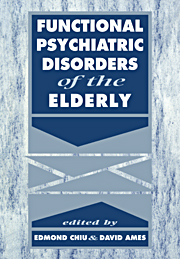Book contents
- Frontmatter
- Contents
- List of contributors
- Preface
- Introduction – A personal note
- Acknowledgement
- Part 1 Classification
- Part 2 General epidemiology
- Part 3 Neuroses
- Part 4 Affective disorders
- Part 5 Psychosexual disorders
- Part 6 Substance use and abuse
- Part 7 Schizophrenia and related psychoses
- 17 The elderly with schizophrenia
- 18 Late onset paranoid disorders:
- 19 Community or asylum? finding a place to care for the elderly psychiatric patient
- Part 8 Psychological, biological and medical issues
- Part 9 Treatment methods
- Part 10 Conclusion
- Index
17 - The elderly with schizophrenia
from Part 7 - Schizophrenia and related psychoses
Published online by Cambridge University Press: 13 November 2009
- Frontmatter
- Contents
- List of contributors
- Preface
- Introduction – A personal note
- Acknowledgement
- Part 1 Classification
- Part 2 General epidemiology
- Part 3 Neuroses
- Part 4 Affective disorders
- Part 5 Psychosexual disorders
- Part 6 Substance use and abuse
- Part 7 Schizophrenia and related psychoses
- 17 The elderly with schizophrenia
- 18 Late onset paranoid disorders:
- 19 Community or asylum? finding a place to care for the elderly psychiatric patient
- Part 8 Psychological, biological and medical issues
- Part 9 Treatment methods
- Part 10 Conclusion
- Index
Summary
Historical developments
Several factors have contributed to a growing interest and concern for elderly individuals with a history of schizophrenia. Demographic changes in an aging society as well as the reduced hospital mortality of schizophrenic patients, once at a very high risk especially for tuberculosis, have enabled an increasing number of these persons to become of age. Due to more active strategies in treatment and rehabilitation, such as effective control of productive symptomatology by antipsychotic medication as well as the provision of outpatient and complementary facilities, the duration of inpatient stay has dramatically decreased. Thus, individuals with a history of schizophrenia have become more visible in the community. Extensive long-term follow-up research has revitalized therapeutic activity and optimism even for the chronically hospitalized, because the outcome of schizophrenia was found to be more favorable than expected. ‘It is worth trying to help schizophrenics’ (Bleuler, 1974) once thought to suffer from a disease process inevitably leading to dementia.
Epidemiology of the elderly with schizophrenia
The incidence of schizophrenia in the elderly (i.e. onset of the disorder after age 65) is considered to approximate zero if the frequent paranoid states in the elderly, organic psychoses and similar delusional disorders without first-rank symptoms of schizophrenia are carefully ruled out (Bleuler, 1972; Huber, Gross & Schüttler, 1979).
Community studies on the prevalence of schizophrenia among the elderly (Krauss, 1989) have found rates ranging from 0.1% to 1.7%. For an overall estimate of the prevalence, some of these figures are possibly too low, because many chronic patients live quite adapted in homes and most prevalence studies did not include individuals in residential care.
- Type
- Chapter
- Information
- Functional Psychiatric Disorders of the Elderly , pp. 287 - 302Publisher: Cambridge University PressPrint publication year: 1994
- 2
- Cited by



